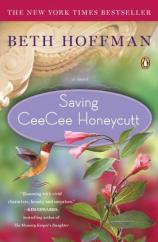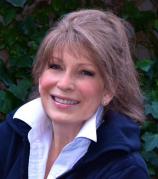Interview: January 15, 2010
January 15, 2010
Beth Hoffman's debut work of fiction, SAVING CEECEE HONEYCUTT, is a coming-of-age tale about a recently orphaned 12-year-old girl who finds a new home with an eccentric elderly aunt in 1960s Savannah. In this interview with Bookreporter.com's Jamie Layton, Hoffman traces the inspiration for the book's plot back to a childhood memory, as well as her fascination with mother/daughter relationships, and elaborates on some of the pivotal roles played by secondary characters in the novel. She also reveals what prompted her to turn to writing amidst a successful career in design, responds to comparisons made between her work and recent Southern Fiction bestsellers, and shares her whirlwind experiences as a first-time novelist.
Bookreporter.com: Every book starts with an idea. How did you begin developing the story of SAVING CEECEE HONEYCUTT, and how did it grow from there?
Beth Hoffman: The initial spark of my novel ignited when I was nine years old. I had taken a train from Ohio to visit my Great Aunt Mildred Caldwell in Danville, Kentucky, and from the moment of my arrival it was culture shock of the best kind. There I was, a shy little farm girl suddenly in the midst of a world I could have never imagined. I was in awe of the massive old homes, the towering trees, and the lush flower gardens, and I was enthralled by the Southern dialect.
My great aunt Mildred was an accomplished, highly educated woman, and she was a true Southern lady. I’ve never met anyone more gracious, and I suspect I never will. Everyone was welcome in her home, and she greeted people with a smile that was as warm as it was genuine.
Added to that experience is my fascination with the complexities of mother/daughter relationships, so all those things became seeds for my idea. And I adore eccentric personalities and the architecture of the American South. Each of those elements built the framework of my story.
BRC: I understand that Aunt Tootie has some foundations in a great-aunt. Of the characters, was it her voice that you started with? If not, who came to you first?
BH: CeeCee arrived first. I had begun a rough outline, and late one night CeeCee simply appeared. Her voice was so clear that it rocked me back in the chair, and her story was far better than mine! So I deleted my outline and listened to what CeeCee had to say.
BRC: CeeCee’s life is filled with vivid female figures. Many comparisons (fair or not) can be made between CeeCee’s mother, Camille Honeycutt, and Aunt Tootie, as well as between Mrs. Odell and Oletta Jones. Was it your intention for CeeCee’s mother figures from her life in Ohio to have counterparts in her Savannah world?
BH: Though mother figures certainly have universal qualities, the juxtaposition of my characters’ personalities evolved throughout the manuscript by way of how they impacted CeeCee, and here’s how I saw them: Mrs. Odell was akin to a kindly great-grandmother; Aunt Tootie was unique in her zest for life and her selflessness, but it was Oletta who wore the two most distinctive hats. Not only was she a mother figure, she became so much more.
CeeCee had longed for a friend --- to know what it was like to hear her footsteps go down the sidewalk in rhythm with those of a girlfriend. I wanted CeeCee to experience that wishes and dreams can come true, and oftentimes in surprising ways. CeeCee’s wish was genuine, with no criteria or limitations, and through her wonderful friendship with Oletta, she learned that friends could come in all sorts of ways, and in all different colors and ages.
As for Thelma Rae, she was wonderfully eccentric, but she wasn’t mentally ill like Camille. It was vital that CeeCee be exposed to a colorful woman who was a true free spirit, but not dancing on the edge of madness. Through CeeCee’s interactions with Thelma Rae, she saw the difference between eccentric personalities and those who are sadly and genuinely crazy.
BRC: Almost all of your characters --- primary and secondary --- are female. Did this happen purely by accident or was it formulated? Do you think authors naturally tend to create characters who mirror their own sex, or does this not matter?
BH: CeeCee’s dad is an important character in the story. Though his presence is limited, his own personal transformation throughout the book was essential to CeeCee’s healing and her ultimate ability to forgive. I have no problem with writing about men, but CeeCee’s story demanded that the major players be females. I had originally put two male characters in the book, and on my second full edit, I knew they had to be cut because they simply didn’t advance the story in the way that was necessary.
BRC: In the book, there are many scenes I was sure would lead to a heart-sinking turn of events --- like the incident at Tybee Island or Oletta’s discovery of CeeCee’s letters to Miss Hobbs. Aside from her mother’s accident, you managed to avoid any truly “bad” things happening and yet still convincingly tell CeeCee’s story. Was it difficult to refrain from such expected storylines?
BH: Thank you for acknowledging what I had worked so hard to achieve. What I wanted was to never allow the story to veer off into avenues that didn’t promote CeeCee healing. I certainly wanted CeeCee to have some profound experiences and realizations, but I refused to get all caught up in social issues that didn’t advance CeeCee’s story in meaningful and highly personal ways. By respecting the tone of the story and being diligent to keep my writing focused on CeeCee’s perspective, I was able to accomplish what I had set out to do: to tell her story in her voice.
BRC: The first 12 years of CeeCee Honeycutt’s life are dominated by her almost hermetic life with her mentally ill mother, Camille, a former (and in her own mind present) beauty pageant Queen. If you changed the year from 1967 to present day but everything else about the book's basis remains the same --- i.e. 12-year-old girl, mentally ill mother, absentee father, small town --- do you think CeeCee would still have been left to manage her mother all by herself? Do you think people would be more apt to intervene in the situation today?
BH: Maybe. Though there are far more agencies to protect children now than there were in the ’60s, there are countless children living with mentally ill/unstable parents. CeeCee’s mother was not abusive, nor was her dad --- neglectful yes, but never abusive. People in the ’60s were far less inclined to poke around in other people’s lives, but even in today’s world, unless a relative, teacher, or neighbor contacts the appropriate parties, little will be done when a child is living with a mentally ill parent.
BRC: Many have compared your novel to the bestsellers THE SECRET LIFE OF BEES and THE HELP, and, granted, there are similarities among the three books. Yet SAVING CEECEE HONEYCUTT remains an original, fresh story. How do you shoulder the weight of such analogies?
BH: CeeCee is simply CeeCee. I firmly believe that one of the absolute worst things a novelist can do is give emotional energy to any comparisons to other writers or their works. We all have our own unique gifts, our own voices, and certainly our own stories. If anything, I think those who have compared the flavor and emotional colors of my work to Steel Magnolias are probably the most accurate.
BRC: As a writer, how do you keep a lifetime of reading other people’s books from sneaking into your own story? It seems an almost impossible task to set up the boundaries that prevent these other voices and anecdotes from entering your own work. How do you manage to accomplish this?
BH: I can’t speak for other writers, but my personality keeps me focused on my own creativity. As a painter and an interior designer, I worked diligently to develop my own unique signature --- a signature that I cultivated for over 25 years. And that has carried over to my writing. Whatever I write, paint on a canvas, or create in an interior, I want it to reflect my own style.
BRC: Pick one word (for example: redemption, grace, revenge, codfish) and finish this sentence: SAVING CEECEE HONEYCUTT is about _________. Why have you chosen that word to best describe your book?
BH: Kindness. I believe that when we are kind, or when we make a conscious decision to BE kind, we not only open ourselves up to remarkable experiences, but we also open our hearts, and in doing so, we discover the greatest strength of our character. When we can shove our agendas and all our “stuff” aside, we grow and learn at a rapid pace. Ordinary people do extraordinary things every day, and I believe those things all come from a single common denominator --- kindness.
BRC: You have said that the impetus to “plunk down at the computer” and begin writing full-time was a comment from a complete stranger. Can you tell us more about that?
BH: I nearly died of septicemia, and it was a long road to recovery. After finally being discharged from the hospital, I returned home to convalesce. While I struggled to regain my health and find spiritual ballast, my childhood dream of writing a novel resurfaced. But no matter how I looked at it, there just weren’t enough hours in the day to fulfill the demands of my career and write a novel. So I let the dream go.
To satisfy my desire to write, I began creating "story ads" for the design studio. I'd select a piece of furniture and then write a story about who owned it, who wished they owned it, or who was trying to win custody of it in a divorce. The ads became a hit, and soon people started calling about them and some people even began collecting them. Well, one snowy morning a man called and asked to speak to the person who wrote the ads. He and I talked for a few minutes, and he told me how he and his wife enjoyed reading the ads over coffee on Saturday mornings. Before we said goodbye, he commented that if I could write a compelling story in just a few sentences, had I ever considered writing a book.
And that did it. I knew if I were ever going to write a novel, it was now or never. I chose now. Oh, it was the gutsiest thing I've ever done. After selling my portion of the design business, I went home, plunked down at the keyboard and began to write. Four years later I typed THE END.
BRC: Can you describe your experience, thus far, as a debut novelist?
BH: It’s a whirlwind that’s both exciting and exhausting. I never imagined that CeeCee’s story would be so fully embraced. And though I certainly knew a great deal about Pamela Dorman and her incredible eye for women’s fiction, and had even allowed myself to dream that she would want my novel, when it actually happened, I was gobsmacked. I’ve met so many extraordinary people, and I’ve established wonderful friendships with book bloggers and authors. This is a new chapter in my life that I plan to enjoy to the fullest.
BRC: Any hints as to what are you working on now?
BH: A few new characters have appeared, and I have some storyline ideas, but nothing really concrete. My book tour is extensive, and I know when that’s behind me, I’ll be able to sit down and write constructively. I miss writing something fierce, and I can’t wait to return to my keyboard.
• Click here now to buy this book from Amazon.
© Copyright 1996-2011, Bookreporter.com. All rights reserved.




